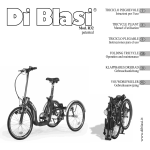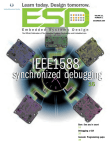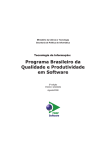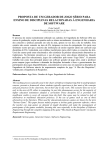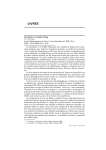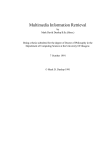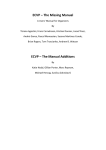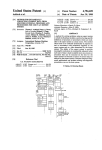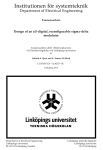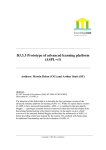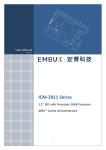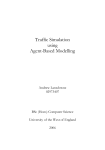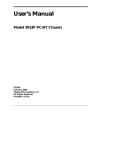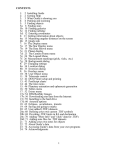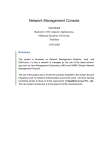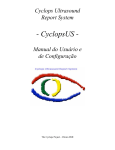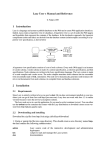Download The Development of Agent Support for a Case
Transcript
The Road to ASCRARAD: The Development of
Agent Support for a Case-based Reuse
Application for Rapid Application Development
Stein Inge Morisbak
June 22, 2000
ii
Contents
1 Introduction
1
2 Theory and Method
3
3 The Environment and Agents
15
4 Agent Organization
33
5 Agent Interaction
39
6 Comparison and Test Results
47
7 Conclusions and Further Development
53
A Usage / user manual
61
B Installing and running the application
73
References
77
iii
iv
Contents
Chapter 1
Introduction
To support programming in Java, a tool, Case-based support for Rapid Application
Development [65], has been developed which makes it possible to search through potentially reusable Java classes. The tool is based on case-based methods to support
retrieval and reuse.
The purpose of this project, ASCRARAD, is to add agent support to the retrieval mechanism of this tool. This should optimize retrieval efficiency and free the user’s hands
and mind making it possible for the user to concentrate fully on her task.
Rapid Application Development is a technique used to obtain insight into system requirements by experimenting with partial implementations. To be effective, it must be
possible to create a prototype with a minimal investment of time and resources. The
purpose of this approach is to develop a prototype of portions of the proposed system
to determine the necessity, desirability, or feasibility of certain requirements. The pur1
2
C HAPTER 1. I NTRODUCTION
pose of such a prototype is to help the end-user and developer to come to a mutual
understanding of the system requirements and decide on a final design.
One mechanism for decreasing development time is the effective reuse of previously
engineered components. A software company may have a large repository of previously developed components, and to make the reuse of these more effective, will
contribute a great deal to the development process. These mechanisms are especially
helpful for newly employed and novices since they don’t have the experience working
with and the overview of the firm’s repository.
The ASCRARAD tool helps the developer to locate code for potential reuse in an
automated way and in the background. The tool aids in program understanding and
adaptation. It allows an exploratory approach to program development and optimizes
reuse efficiency.
I will in this thesis present ”The Road to ASCRARAD”. In other words, the theory
behind and the process of the development of the agent support. I will start with a theory chapter describing the concepts of AI Method, Agent Orientation, ”Intelligence”,
Case-based Reasoning and the Java programming language (Chapter 2).I will continue with a brief presentation of the tool developed by Bjørnar Tessem et al before
I go on to a more detailed description of the Agent support and architecture. I will
try to describe my chosen implementation strategy and to justify this choice(Chapter 3
and 4). Chapter 5 is about agent language and interaction. Some example runs will
be presented in Chapter 6. I will conclude with a summary and some thoughts about
further development and possibilities in Chapter 7.
2
Chapter 2
Theory and Method
The main purpose of this project is to implement an agent architecture suitable for
retrieval of cases in a Case-based Reasoning tool for Rapid Application Development.
I have decided to create an architecture where each case in the repository is an active
case (or agent) and where a hierarchical structure of agents provide an organization
analogy useful to implement the retrieval mechanisms and rules. The big question
was; ”can agent support prove to be useful for retrieval of cases in a Rapid Application
Development environment based on CBR-techniques?”
2.1 AI Method
Scientific method in artificial intelligence (AI) is often characterized by an experimental or explorative angle of incidence. I have chosen to follow an approach based on
3
4
C HAPTER 2. T HEORY
AND
M ETHOD
this method.
AI is the study of the mechanisms underlying intelligent behavior
through the construction and evaluation of artifacts that enact those mechanisms. [36, p 755]
This definition of artificial intelligence (AI) is a description of a method for experimenting rather than a theory about those mechanisms underlying intelligence. It tells
us that the mechanisms are best studied through design, execution and evaluation of
experiments with improvement of models and further experimentation as a goal. As
an empirical science, AI takes a constructive approach; we attempt to understand intelligence by building a working model of it. Hence, AI is also engineering.
AI uses much of the theory we find in cognitive psychology [43, 54, 4, 16], evolutionary psychology [5, 11, 12] and organizational and social psychology [40, 21, 35].
We wish to let computers perform tasks which, if humans carried them out, would
be viewed upon as something demanding intelligence. The task for AI research is to
find tasks demanding intelligence and to see what processes are sufficient to accomplish these. Through experimentation with alternative models and implementations
you can find out much about the principals for intelligence, both individual and corporate. Principles that are best understood through repetitively experimentation, trying
and failing.
The moment of truth is a running program [59, p 96]
Herbert A. Simon [59] states that the main method within AI consists of building and
studying systems that exhibit intelligence. Three points sum up the method:
1. Choose a task incorporating a feature of intelligence that is of substantial practical importance or that exhibits features and complexities that have not yet been
simulated by AI systems.
4
2.2. AGENT O RIENTATION
VS .
O BJECT O RIENTATION
5
2. Build a system exhibiting this feature of intelligence.
3. Examine the behavior of the system in different task environments and with
different initial conditions.
I decided to build an agent-architecture performing ”intelligent” actions in a complex
environment where experimentation with different initial conditions and different task
environments is possible.
2.2 Agent Orientation vs. Object Orientation
Objects and agents share many things in common, but in my view differences exist
which makes a useful and important perspective for system development. In traditional
object orientation, objects are considered passive because their methods are invoked
only when some external entity sends them a message. Software agents have their
own thread of control, localizing not only code and state but their invocation as well.
Such agents can also have individual rules and goals, making them appear like ”active
objects with initiative” or as Jeffrey Bradshaw puts it ”objects with an attitude” [8]. In
other words, when and how an agent acts, is determined by the agent.
Agents are regarded as autonomous entities because they can watch out for their own
set of internal responsibilities. Furthermore, agents are interactive entities that are capable of using rich forms of messages. These messages can support method invocation
as well as informing the agents of particular events, asking something of the agent, or
receiving a response to an earlier query. Lastly, because agents are autonomous they
can initiate interaction and respond to a message in anyway they choose. In other
words, agents can be thought of as objects that can say ”No” as well as ”Go” [45].
It is not entirely correct that OO doesn’t support many of the properties ascribed to
agents. OO technology can be extended in various ways to support many of the prop5
6
C HAPTER 2. T HEORY
AND
M ETHOD
erties ascribed to agents. (E. g. process and thread can be considered active
objects). The point here is that the agent-based approach is an extension to how we
think in an OO world. Agents, then, are an evolution rather than a revolution. It is
another way of thinking about systems and their implementations, i. e. an extension to
the way of thinking in the OO approach.
The autonomous and interactive character of agents more closely resembles natural
systems than do objects. Since nature has long been very successful, identifying analogous situations to be used in agent-based systems is sensible. We can e. g. think of
agents as being a part of an environment where they have the potentiality of surviving
and succeeding, the ability to command resources and cooperate with others, and the
possibility of failure, replacement and even death. As an example, the ASCRARAD
solution uses an organization analogy. The system is organized in departments where
each department consists of a group of workers with special features that devises them
from the rest of the organization’s workforce. A coordinator leads each department
and the Manager leads the whole organization. Each member has the potentiality of
surviving and succeeding but also the possibility of replacement and death. They communicate by sending messages to each other and the command line is top-down (Chapter 4).
There are many other areas than autonomy and interaction that can differentiate the
agent-based approach from traditional OO [45], but I think the most important distinction is the computational model used to solve the problem. In most cases the problem
can be solved both ways. The resulting program may look just the same externally,
but agent-based programming should be able to deal with complexity and adaptability better. Agents can be viewed as an extension of objects. An object is something
that encapsulates its identity (who), its state (what), and its behavior (how). An active
object encapsulates its own thread of control (when). An agent may have all of these,
but it must have something else. A common approach is that an agent encapsulates
why it does something. Objects have a specific contract that defines their behavior,
6
2.3. ”I NTELLIGENCE ”
7
while agents, like humans, have only a generic interface to interact with others and the
environment. Contracts between agents are negotiated at a meta-level. They are not
implicit in the interface. Agents (like humans) can only attempt to get other agents to
believe or do something.
2.3 ”Intelligence”
After decades, the term intelligent has still not been defined (or understood) for artificial systems and applying it to agents may not be appropriate. Most tend to regard the
term agent and intelligent agent as equivalent. Perhaps this is just an attempt to communicate that agents have more power than conventional approaches. Agents could be,
e. g. in comparison to relational tables or objects, thought of as somewhat ”smarter”.
Or, it could just be marketing hype. However, it would be fair to say that the notion of
intelligence for agents could very well be different than for humans. We are not creating agents to replace humans; instead, we are creating them to assist or supplement
humans. A different kind of intelligence, then, would be entirely appropriate.
If the science of artificial intelligence has made any contribution to
human knowledge, it is in confirming that intelligence is not some mystic
vapor permeating men and angels, but rather the effect of a set of general
principles that can be understood and applied to the design of intelligent
machines.[36, p 75]
Whatever the term intelligent agent means, such agents will require a set of attributes
and facilities. E. g. an intelligent agents state must be formalized by knowledge (i.
e. beliefs, goals, desires, intentions, plans, assumptions) and be able to act on this
knowledge. It should be able to examine its beliefs and desires, form its intentions,
plan what actions it will perform based on certain assumptions, and eventually act on
7
8
C HAPTER 2. T HEORY
AND
M ETHOD
its plans [14]. Furthermore, intelligent agents must be able to interact with other agents
using symbolic language (Chapter 5).
The interaction of many individual agents can give rise to secondary “intelligent” effects where groups of agents behave as a single entity. An agent organization consists
of individual agents acting according to their own rules and individual goals, but the
achievements as a whole can be viewed as greater than the sum of its individual contributors.
Emergent intelligence is viewed as a phenomenon resident in and emerging from a
society and not just a property of an individual. Intelligence is reflected by the collective behaviors of large numbers of simple interacting agent. So whether we take these
agents to be neural cells, individual members of species, or single persons in a society,
their interactions produce intelligence.
ASCRARAD uses a metaphor from the organizational structure of an enterprise (see
chapter 4). The intelligence in the solution arise from the interactions of all the simple,
individual, embodied agents.
All this sounds like models of rational human thinking, and that is exactly what it is.
Our understanding of how humans think and how they act together in societies is used
as a model for designing agents and agent systems, or as James Odell says it, we should
use life as a metaphor[44] to build these systems.
Since the term intelligent is somewhat controversial in computer science and perhaps
not applicable to the type of agents I have developed, I will use agent, not intelligent
agent, as the term for the type of agents in this system. Instead I will assume a level of
agent competency sufficient to allow them to communicate and work together to perform useful tasks, to accept or infer instructions or requests regarding its activities, and
to use these to shape its autonomous activity decisions. Such agents are the building
blocks of the agent organization. The agent system falls somewhere between a simple
8
2.4. C ASE - BASED R EASONING
9
event-triggered program and one with human collaborative abilities. It’s probably far
to the former side of the spectrum.
2.4 Case-based Reasoning
Case-based reasoning (CBR) is a general method for reasoning on the background of
experience. CBR is a retainment model for representation, indexing and organization
of previous cases, and a process model for retrieval and modification of old cases and
assimilation of new ones. A case usually describes a problem situation.
A previously experienced situation, which has been captured and learned in a way
that it can be reused in the solving of future problems, is referred to as a base case,
past case, previous case, stored case, or retained case. A new case (target case) is
the description of a new problem to be solved. The technique utilizes similarities in
problem descriptions to select and adapt previous solutions to new situations. Casebased reasoning is therefore a cyclic and integrated process that consists of solving a
problem, learning from this experience, solving a new problem, etc.
Generally a CBR cycle may be described by the following four processes:
1. RETRIEVAL of the most similar case (base case).
2. REUSE of the information and knowledge in the base case. Adaptation and
mapping of the base case to the present problem (target case).
3. REVISE the proposed solution (evaluate and correct).
4. RETAINMENT of the parts of this experience that may be useful for future
problem solving. The new case (problem description and adapted solution) is
stored in the case base for future reuses (the learning process).
9
10
C HAPTER 2. T HEORY
AND
M ETHOD
Instead of general knowledge about a domain the system stores case descriptions and
their associated solutions that are retrieved, adapted and utilized in the solution of new
problems. There are many advantages with this approach. Some of them are:
- Simple knowledge acquisition: We record a human expert’s solutions or
experiences from real life to a number of problems and let a case-based
reasoner select and reason from the appropriate case.
- Generalization using cases: This saves us the trouble of building general
rules from the examples. Instead the reasoner would generalize the rules
automatically through the process of applying them to new situations.
- Learning: After reaching a search based solution to a problem, a system
can save that solution, so that next time a similar situation occurs, search
would not be necessary. It can also be important to retain in the case
base information about the success or failure of previous solution attempts;
thus, CBR offers a powerful model of learning.
This description of CBR is based on Aamodt and Plazas ideas as they are expressed
in the article Case-based Reasoning: Foundational issues, methodological variations,
and system approaches [1].
2.5 Why Java?
Java is a class-based object-oriented programming language supporting encapsulation,
inheritance and polymorphism. These features guide system organization and are intended to promote the reuseability of the resulting software components.
Java is intended to allow application developers to write a program once and then be
able to run it anywhere [26]. This, and that the Java naming scheme facilitates the
10
2.5. W HY JAVA ?
11
sharing of object classes among distributed developers without having to duplicate
software modules, contributes to reuseability.
Software development with Java can therefore be viewed as a constructive activity
where system functionality is composed from a set of existing components.
Java Reflection enables Java code to discover information about the fields, methods,
and constructors of loaded classes, and to use reflected fields, methods and constructors
to operate on their underlying counterparts at runtime [26]. This capability allows us to
extract feature descriptions from compiled classes without having access to the source
code.
Java has a set of powerful mechanisms that directly support software reuse. However,
the developer must have a sufficient knowledge of the language environment to be able
to construct a mental mapping from existing object classes to the class that he wishes to
construct. Java supports this to some extent in that it is possible to inherit the structure
and functionality of an existing class and only specify new behavioral features in the
new object class1 .
2.5.1 Extending Java’s Reuseability?
The software developer is left without support for acquiring an intimate knowledge of
the contents of all the class libraries that are available for reuse. This may explain why
object-oriented programming has such a steep learning curve [46]. Much of the effort
of becoming an effective programmer in an object-oriented environment is expended
in becoming familiar with the existing class libraries. This is made even worse if the
1
Java does not provide multiple inheritance. The interface construct allows classes and their
descendants to define and implement several interfaces as a set of methods. An interface can then be
used by other classes as a form of contract. So, while Java only allows single inheritance for classes,
a single class can implement multiple interfaces, and an interface can be defined as an extension of
multiple other interfaces.[30]
11
12
C HAPTER 2. T HEORY
AND
M ETHOD
class repository is dynamic (i. e., constantly being extended by multiple programmers).
The purpose of a case-based retrieval and reuse tool is to help the developer to locate
reusable code and to aid in program understanding and adaptation. The tool matches
Java classes from the class repository (base cases) to the target case (the class under
construction) and then suggests similarities between them.
It is wrong to say that it extends Java’s reuseability since the case descriptions are constructed using Javas own artifacts. One could say though, that it enhances reuseability
in that it automates, ensures the quality of -, and aids in understanding of - the process.
Since the tool uses Java reflection and reuseability it doesn’t require additional work on
the part of the software developers. Furthermore it ensures that the automated retrieval
and adaption strategies will be immediately useful and work with existing software
repositories. However, it should be noted that the same approach to feature extraction
could be implemented in any other programming environment in which access to the
source code for the components is available.
2.5.2 Java Agents
Java provides all of the functionality required to design and implement software agents.
Besides Mobility2 , a feature not used here, it provides support for Autonomy and Artificial Intelligence.
Autonomy - For a software program to be autonomous, it has to be a separate process
or thread. Java applications are separate processes and may therefore last long and be
autonomous. An agent can be a single thread. Java supports multithreaded applications
and hence autonomy using both techniques.
2
The Java Virtual Machine offers a homogeneous interface for Java processes, something that lets
Java agents move between heterogeneous hardware systems.
12
2.6. B RINGING
13
IT ALL TOGETHER
Pattie Maes [37], head of MIT’s Media Labs agents group defines an agent to be
a process that lives in the world of computers and computer networks
and can operate autonomously to fulfill one or more tasks [38].
Agents are autonomous programs or processes. These processes are always ready to
respond to a user’s action or a change in the environment. The agents are informed
about changes in the environment by messages (see Chapter 5) being sent to them.
Intelligence - Two main aspects of Artificial Intelligence (AI) are knowledge representation and algorithms manipulating these. Knowledge representation is often based on
the use of slots or attributes that store information about some entity, and chains or
references to other entities. Java objects may be used to code this data and behavior
as well as relations between objects. Standard AI knowledge representation such as
frames, semantic networks, and if-then rules may easily and naturally be implemented
in Java.
2.6 Bringing it all together
Following AI method I have identified a main task for the agents and system as a whole.
This task is to retrieve software components for reuse. The task can be viewed as
demanding “intelligence” since the location of such code requires search, recognition
and comparison of code features and which, if it should have been carried out by a
human, would demand knowledge, experience and skill to accomplish.
Recalling Pattie Maes’ definition from Section 2.5.2, an agent is
a process that lives in the world of computers and computer networks
and can operate autonomously to fulfill one or more tasks [38].
13
14
C HAPTER 2. T HEORY
AND
M ETHOD
This definition describes the features an agent has to possess, but in relation to ASCRARAD
it also expresses why agents are particularly suitable in this type of environment. The
concept of agents being autonomous makes it possible for the user to concentrate fully
on her task. Agent-orientation is a great computational model for creating autonomous
systems, and I believe that agent support could become excellent help for the user.
Case-based Reasoning(CBR) is a problem solving paradigm that uses knowledge of
relevant past cases to interpret or to solve a new problem case. The technique constitutes a natural approach to represent the experience acquired in the design of past
software components. CBR is especially suitable when dealing with object-oriented
design where software development usually relies on previously developed object
classes.
In the Java programming language the base case descriptions can be constructed from
the software artifacts themselves using Java reflection. Java is also suitable for implementing agent societies since it supports multithreaded applications.
These choices of method, techniques and models have been used as the basis for the
development of ASCRARAD.
14
Chapter 3
The Environment and Agents
3.1 Case-based Support for RAD
Rapid Application Development(RAD) is a technique for achieving insight into system requirements by experimenting with partial implementations. Reuse of previously
developed components assists this process. Tessem et al [65] have developed a tool
where the reuse method is case-based and integrated in an environment specialized for
rapid prototyping.
The environment consists of an integrated editor, and a reuse tool. The reuse tool
can be used on partial class specifications to identify components that may be candidates for reuse. In addition it supports the reuse process of the chosen components.
The case-based reuse tool supports retrieval and reuse of classes based on their signatures (methods return types and arguments etc.), which in this case is viewed upon
15
16
C HAPTER 3. T HE E NVIRONMENT
AND
AGENTS
as cases. From these signatures one may also extract some knowledge about what
kind of component this is. For instance, whether it is a collection of some kind. The
reuse component may suggest mappings between signatures of a retrieved case and the
target, and the user may accept or discard the suggestions. In addition the reuse tool
suggests how to reuse a class, either by extension, or by lexical reuse of source code
(if it is available). Java’s reflective capabilities are used to extract case descriptions
from compiled Java classes, and case-based reasoning is applied to support retrieval
and adaptation of reusable components. The purpose of the tool is to localize potentially reusable code and to support the programmer in her program understanding and
adaptation of the code.
Research done by Tessem et al has shown that the set of features that can be automatically extracted utilizing the Java reflective capabilities (e. g., method signatures, field
types, inheritance information, etc.) can be effectively used to retrieve components for
subsequent reuse. The fact that case descriptions are extracted automatically increases
the chances for acceptance of the approach in real programming environments and circumvents the high start-up costs traditionally associated with establishing repositories
of reusable components.
Figure 3.1 is a conceptual diagram of the Rapid Application Development Environment from the article Case-based Support for Rapid Application Development [65].
An earlier version of the system included a Java interpreter. This is shown in the figure
as a grey box since it is no longer part of the environment. As development progresses,
portions of the software could be sent to the interpreter for immediate feedback. This is
a great feature in RAD tools and should be introduced again (See section 7.2.2 Editor
Improvements).
16
3.2. AGENT S UPPORTED C ASE - BASED R ETRIEVAL
17
Reuse
Tool
Extracted signatures
Editor
Version
under development
Source
Parse
Interpret
TypeCheck
ByteCompiled
Mapper
Class
Repository
Case-Based
Retriever
Figure 3.1: Conceptual Diagram of Rapid Development Environment
3.2 Agent Supported Case-based Retrieval
A user of such a tool must repetitively and actively ask for reuse support. An alternative to this is one or more intelligent agents observing the implementation the user
builds, and when the similarity to a class is good enough notifies the programmer. The
Agent Supported Case-based Reasoning Application for Rapid Application Development( ASCRARAD) tool is an attempt to support these features. It is based on the
work done by Tessem et al and extends their work with the implementation of agent
support.
17
18
C HAPTER 3. T HE E NVIRONMENT
AND
AGENTS
Figure 3.2 is a conceptual diagram of the Rapid Application Development Environment with Agents.
Reuse
Tool
Manager
Extracted signatures
Editor
Version
under development
Source
Parse
Interpret
TypeCheck
Coordinators
ByteCompiled
Workforce
Mapper
Class
Repository
Figure 3.2: Conceptual Diagram of Rapid Development Environment with Agents
The Manager agent monitors the programmer’s implementation via the extracted signatures of the partial class specification and compiles the code when needed. A re–
introduction of the interpreter would allow the Manager to test–run uncompiled Java
statements; thus check the syntax of the expressions. This is however not implemented,
but may be a great idea for further development (See section 7.2.2). The Manager agent
then passes the task on to the appropriate Coordinator agents. Each Coordinator have
more specific knowledge about a certain group of cases. If a Coordinator thinks that
his group of cases may be relevant for the user, it sends a message to the workforce
agents in this group. Such a group is in reality the class members of a Java package
18
3.2. AGENT S UPPORTED C ASE - BASED R ETRIEVAL
19
[63], and a single workforce agent is in reality a single case description of a Java class.
3.2.1 The Manager Agent
On the top level we find ”the Manager agent”. The Manager handles the interaction
with the user and controls the retrieval process. When reusable cases are found the user
is notified by a ”Case Found!” message in a small window at the bottom of the source
editor (See Section 3.3 The Editor). A menu pops up on the menu line containing to
choices. The user may choose to ignore the agents message by pressing ”Ignore”, or
she may start the reuse tool.
The Manager also monitors the coding. The user specifies how often (a time interval)
or under what condition (number of code lines in the editor) the Manager should interpret the code and make a target case for the retrieval process. The Manager interprets
the code following the user specification and passes a message to the next layer of
agents, namely the Coordinators.
3.2.2 The Coordinator Agents
Coordinators are ”package cases”. The logical grouping of cases and the concept
of Coordinators are based on the Java concept ”Packages” [26]. Java programs are
organized as sets of packages. Each set has its own set of names for types, which help
to prevent name conflicts. The naming structure for packages is hierarchical which is
convenient for organizing related packages in a conventional manner. A Coordinator
agent represents a single package in the repository as a ”package case”. A package
case consists of all the types (method return types, fields and argument lists) of all the
classes in a Java package. Each value has a significance attribution. The significance
of a type in a certain package is a calculation of its number of occurrences in a case
in relation to occurrences in each other package and in the whole repository. The
19
20
C HAPTER 3. T HE E NVIRONMENT
AND
AGENTS
significance of a type is hence a value used in the matching with the target case’s
types. If a type in the target case matches a highly significant type in a package it
increases the Coordinators ”willingness” to fire an event to its workforce. If it finds
that classes in the package contain highly significant types for this particular target
case it will pass the target case to the workforce for further matching. Coordinators
that have good match, but not the best, will keep on living in memory, but they won’t
fire events (See Estimating The Relevance of a Target Type). There’s reason to believe
that these Coordinators may be relevant when the user continues with extending her
class. Therefore we keep them in memory for the next round of matching. If the
Coordinators workforce is found to not contain many significant types for the target
case, it dies.
Estimating the Significance of a Type
The estimation of a types significance in a package is calculated in the following steps.
The package java.applet (containing four classes), the class java.applet.Applet
and the type URL is used as an example in a JDK1.1.8 repository containing 78 packages:
1. Count the number of occurrences of a particular type in a single class:
F ORMULA 3.1
class
count type 20
3.2. AGENT S UPPORTED C ASE - BASED R ETRIEVAL
21
E XAMPLE 3.2
class
type !"
" $#&%
'
2. Divide the number of occurrences of a particular type in a single class by the
total number of references to types in the class (java.applet.Applet has
55 different types):
F ORMULA 3.3
normalized count (
) = number of references to types in
(
+ * +* $# )
,
+* *.-0/
E XAMPLE 3.4
) = 55
(
" $#
,
121
*.-0/
%
+ * $#43%%
#65 !
5 798
'
3. Sum up all the results from 2. for all classes in a package and receive a sum of
all normalized count (
:* ’s (java.applet contains 4 classes):
21
22
C HAPTER 3. T HE E NVIRONMENT
AND
AGENTS
F ORMULA 3.5
package
package count = number of classes in
+* $#
,
-0/
(
*
E XAMPLE 3.6
package
=4
,
!!" $
#
-0/
(
!" $#65
!
3
'
4. Divide the sum of all normalized ( ’s ( : * ) by the sum of the results from 3.
for all packages in the repository:
F ORMULA 3.7
normalized packagecount ( ( + * +* $# )
,
-0/
E XAMPLE 3.8
5
3
( !" #
#65 77
3
22
'
3.2. AGENT S UPPORTED C ASE - BASED R ETRIEVAL
23
5. Divide the sum of all normalized ( ’s (( * ) by the total number of packages
in the repository (JDK1.1.8 contains 78 packages)::
F ORMULA 3.9
normalized ( ( = number of packages( ) in the repository
,
( * #
( * *.-0/
E XAMPLE 3.10
Sum of all ( for the type URL = 1.790
= 78
( " $#
7
%
5
#65 5 '
6. Calculate the significance of a type in a package by the following formula:
F ORMULA 3.11
significance
( * ( ( #
E XAMPLE 3.12
!!" $#
23
5 7 !7 5 5 #63 8 8
5 5 '
24
C HAPTER 3. T HE E NVIRONMENT
The significance value
AND
AGENTS
is used in a Coordinators matching of a target case with
a package case. In other words, the Coordinator estimates a relevance value for the
target case’s types based on the significance of types in the classes contained in a
package. This process assists in finding out if it is reasonable to believe that packages
may contain case candidates for reuse.
Estimating the Relevance of a Target Type
The estimation of a target case types relevance in a package is calculated in the following steps:
1. Count the number of occurrences of a particular type in the target case:
F ORMULA 3.13
target case
2. Calculate the relevance of the type by the following formula:
F ORMULA 3.14
relevance
#
,
)
*.-0/
24
+* +* 3.2. AGENT S UPPORTED C ASE - BASED R ETRIEVAL
25
3. The total similarity is the sum of the selected relevances:
F ORMULA 3.15
similarity
4. If the total similarity (
* #
,
)
* -0/
*
* ) is a positive number (larger than 0), it’s a
match. If the total similarity is larger than -0.5, the agent continues to live in
memory. If else, the agent dies.
F ORMULA 3.16
If (
* 5 )
then it’s a match!
else if (
* 5
)
then it’s a partial match
else
die!
Unfortunately these heuristics does not give the wanted results alone. Some packages
that contain relevant classes doesn’t always get selected. I have therefore provided the
Coordinator agents with some more knowledge.
Packages where the contained classes don’t “belong together” firmly based on their
relatedness, and where few special types exist (e. g. java.lang and java.util),
will hardly ever be selected. I have therefore hard coded that these very general packages should always be selected. The java.lang package contains the classes that are
25
26
C HAPTER 3. T HE E NVIRONMENT
AND
AGENTS
most central to the Java language, and Java depends directly on several of the classes
(mostly data types) in the java.util package [20]. I believe this is a reasonable
solution since these packages contain core classes used in almost any Java program.
I have also added two checks for class name similarity. The similarities are calculated
based on a string alignment algorithm where, if a good alignment is found, similarity
is set to the length of the longest identical substring relative to the length of the whole
alignment. If the name of the target class is similar to the name of a package (e. g.
MyApplet’s similarity to java.applet is 0.43), the package gets selected. If the
name of the target class is similar to any name of a class contained in a package (e.
g. MyApplet’s similarity to JApplet from javax.swing is 0.75), the package
also gets selected. The target name similarity has to exceed 0.40 for package name
similarity or 0.50 for class name similarity to select the package. According to the
Java Language Specification [26, p 106] it is recommended that naming conventions
should be used in all Java programs, so I also believe this is a reasonable solution. In
Katalagarianos and Vassiliou’s work on software reuse [31] semantic similarity is the
only feature taken into account in the matching.
If a Coordinator agent, based on these calculations, thinks that his Workforce may
contain potentially reusable cases, it passes a message to all the Workforce agents in
the package.
3.2.3 The Workforce Agents
The individual case, or Workforce agent, possesses its own case description. The descriptions are created using Java’s reflective facilities. Java allows any class to be asked
for its methods, fields, constructors, inheritance information, and other information at
run time [63]. Java’s syntactic reuse construct is the import statement. Java uses
an environmental variable called CLASSPATH to establish where to search for classes
26
3.2. AGENT S UPPORTED C ASE - BASED R ETRIEVAL
27
that are mentioned as import statements. The agent supported case-based retriever
traverses the directories on the CLASSPATH environmental variable, extracts all the
feature information for each class in a pre-processing step and stores that information
in a .case file associated with the class for later use. Each .case file is associated
with a Workforce agent. When a base case is matched with a target case it obtains a
value (see Estimating the Similarity below). This value (between 0-1) determines if the
case is a candidate for reuse. If the match is good (greater than a predefined threshold)
the Workforce agent offers it self as a potential case for retrieval. The user specifies
the threshold the case has to match to be considered as a potential case for reuse. If
the match evaluates to half of the threshold, the Workforce agent continues to live in
memory but does not send an event. If not it ”kills” itself. There’s also here, as for the
Coordinators, reason to believe that these Workforce agents may be relevant when the
user continues with extending her class.
Estimating the Similarity
The estimation of the similarity between the target and the base is developed by Tessem
et al and is described in the article Case-based Support for Rapid Application Development [65].
The Workforce agents (base cases) estimate a similarity to the target class using similarities between pairs of methods, constructors, and data fields. To establish a similarity for a base case it does the following steps:
1. For each method, constructor, and data field in the base class use its signature to
compute a similarity to each of the method signatures of the target.
2. For each method, constructor, and data field in the target select the most similar
entry in the base class description and match it to this entry. As the entries in the
base class are selected, mark them not-selectable.
27
28
C HAPTER 3. T HE E NVIRONMENT
AND
AGENTS
3. The total similarity is the sum of the similarities of the selected matches in the
target case. All similarities are represented as a number in the interval 5 7
where 1 indicates maximal similarity.
Similarity between each pair of entries (methods, constructors, fields) are computed
using string identity for types, and string similarity for names. For methods the similarity is computed from three parts:
1. Similarity in return type. Identity gives similarity 1, otherwise 0.
2. Similarity in method name. Identity gives similarity 1, substring containment
gives a similarity which is the size of the contained string relative to the containing string. It also runs a string alignment algorithm on the names, and if a
good alignment is found, similarity is set to the length of the longest identical
substring relative to the length of the whole alignment.
3. Similarity in arguments. If we let the collections of arguments for the two methods be represented as two bags and (bags are like sets, but may have multi-
ple occurrences of same element), then the argument similarity can be given by
the formula:
F ORMULA 3.17
sim # 7
The three similarities are weighted and added into a total similarity for the methods.
Similar approaches are used for constructors and data fields. For constructors only
argument similarity counts, whereas for data fields type and name similarity counts.
28
3.2. AGENT S UPPORTED C ASE - BASED R ETRIEVAL
29
3.2.4 Back to the Manager
The Manager collects all retrieved cases from the different packages. The best cases
are sorted by how well they match the target case and are presented to the user. The
leftover cases (or workforce agents) are kept alive, as they may become potential cases
for reuse in the further development of the target case. In the next round of matching
these leftover cases will be re-matched without having to re-read their features and
invoke them again.
The manager agent’s responsibility in this environment is to independently execute the
case-based matching cycle at the right time and with satisfying feedback.
The agent is able to monitor the users’ code, and when the similarity to a case class
is satisfying enough, give feedback. For this to work smoothly the agent has to know
when to pass the problem to the right coordinator(s), when to disturb the programmers
concentration, and when to start retrieving a case proposed by the coordinators. The
standards for this should be based on the nature of the problem and the programmers
skill level and experience. It is possible for the users to adjust the system to their
individual needs (see Section 3.3).
After retrieving a candidate case the agent provides the user with feedback about what
it has carried out. The agent gives information about which alternatives the programmer has. The alternatives consist in either proposing adaptation of the retrieved case(s)
with help from the reuse assistant, to continue the adaptation independently from the
assistant, or to continue the programming with new searches for others and maybe
more appropriate cases for potential reuse. It is of course also possible to stop the
agent, put it to sleep for a while or to change other settings. The programmer is completely free to follow the agents’ advice or to ignore it.
29
30
C HAPTER 3. T HE E NVIRONMENT
AND
AGENTS
3.3 The Editor
Figure 3.3: Agent supported Rapid Prototyping Environment
The editor’s graphical display is separated into two views (see Figure 3.3). The edit
window, shown on the left, allows the developer to build and edit a class. The developer may either open a previously saved Java file or use the default class. The class
window, shown on the right, reflects the class being developed in the edit window. The
class window contains extracted signatures from the class being developed. This view
is used to compile and/or interpret the current implementation. When the developer
invokes the agents the extracted signatures of the software is used as the basis for the
target class. As the developer extends, changes or starts on a new class the Manager
agent re-reads the extracted signatures for each round of matching.
The Agent Settings Dialog is shown in Figure 3.4. In this dialog you specify how
often the Manager Agent should invoke the reuse cycle in minutes. Alternatively you
can specify that the agent should start when a certain number of code lines has been
exceeded. When you’ve reached the limit of e. g. 30 code lines, the Manager will start
30
3.3. T HE E DITOR
31
the retrieval process. Next time it will start after reaching 30 more (60 code lines).
You can also specify which type of retrieval the Agent should use. You can choose
between ”Reuse (using Workforce)” which means that you try to match the target with
all cases in the repository, or ”Reuse (using Organization)” which means that you
use ”package matching” (See Section 3.2.2) to decide which cases the target should be
matched against. Furthermore you may specify number of cases to be retrieved. Lastly
you specify the threshold. This value tells the agents how well the cases has to match
the target to be considered for retrieval and reuse.
Figure 3.4: Agent Settings Dialog
A complete description of the menus of the graphical interface can be found in Appendix A.2.
31
32
C HAPTER 3. T HE E NVIRONMENT
32
AND
AGENTS
Chapter 4
Agent Organization
In order to get a large number of software agents to work together to perform complex
activities effectively you have to choose some form of agent organization or architecture.
Competent agents that share common communication skills, viewpoints, and purposes
form an agent society. An agent society is a very robust and flexible entity. Agents
within a society can interact with one another (due to common language (see Chapter 5)), identify the abilities and needs of each other (due to common viewpoints),
and request or perform activities on behalf of others (due to common goals). Societal
agents can determine that activities needs to be performed and enlist other agents to
help out. The flexibility of an agent society comes at a cost, however: a substantial
inefficiency in handling ongoing or repetitive activities. This cost begins with the problem of finding appropriate agents for an activity and continues through planning and
33
34
C HAPTER 4. AGENT O RGANIZATION
executing the activity. The flexibility of an agent society starting at square one incurs
the cost of always starting at square one.
Agent societies provide a basis for developing more structured agent organizations.
What is an agent organization? For Galbraith [23], an agent organization is;
1. composed of competent agents,
2. working together to achieve a shared purpose
3. through a division of labor,
4. integrated by decision processes
5. continuously through time.
An organization consists of patterns of behavior and interaction that are relatively stable and change slowly over time.
Sufficiently competent agents (humans) have the ability to organize themselves naturally. This is a direct result of the need to coordinate the work divided among the
agents. In other words, organizing is a basic activity of competent agents. If agent
organizations emerge naturally, why should we bother to design them? The standard
answer for human organizations is that properly designed organizations perform better
than those that emerge naturally [10]. It is reasonable to expect this answer to hold for
software agent organizations as well.
4.1 Choice of organization
I will in the following try to explain the features of my choice of organization and
why I have chosen it. Given an organization design, there must be a mechanism to
34
4.1. C HOICE
35
OF ORGANIZATION
implement it, both within each agent and in the agent-organization architecture. Three
candidates, and explanations to why two of them where rejected, will be presented. I
did however implement two of them (A comparison and test results may be found in
Chapter 6).
4.1.1 Single Agent Architecture
The first model (Figure 4.1) proposed is a single-agent architecture and can hardly be
called an organizational model. It consists of a single agent (A1) controlling the interaction with the user, the interpretation of the user’s actions and work (the construction
of a software component), and the retrieval of cases. The agent is dependent of a global
retrieval mechanism similar to the one proposed by Tessem et al [65]. The advantage
with this architecture is that the Agent is capable of controlling the retrieval process in
the background without user intervention due to its autonomous capabilities.
A1
C1
C2
C3
C4
C5
...
Cn
Figure 4.1: Single Agent Architecture.
4.1.2 Manager/Workforce Architecture (implemented)
A single agent may be pretty smart, but the value gained from agents coordinating
their actions by working in cooperation is greater than that gained from any individual
agent. This is where agents really come into their element.
35
36
C HAPTER 4. AGENT O RGANIZATION
The second approach (Figure 4.2) is a multi-agent system involving relatively uniform
agents (Workforce agents (Aw1 to Awn) ) with a Manager agent (Am) as facilitator,
which handles the interaction with the user and controls the retrieval process. The
Workforce agents have interaction capabilities for communicating with other agents,
local decision-making capabilities for controlling the activities of the agent and the
communications with the Manager agent, and task-level capabilities for performing the
work of the agent. The difference between the Workforce agents in this architectural
structure is only their content. The content of each Workforce agent is an actual case
description.
Am
Aw1
Aw2
Aw3
Aw4
Aw5
...
Awn
Figure 4.2: Manager/Workforce Architecture (Active Cases).
Traditionally cases are viewed upon as passive objects waiting to be retrieved for further decision taking or problem solving. The decision whether cases should be retrieved is taken by a global mechanism. Ye Huang proposes in; An Evolutionary Agent
Model of Case-Based Classification [28], to let the stored cases play a more active
role. The idea is to increase the flexibility of the retrieval process, and to let each case
reflect over its own context and to let cases work together to obtain global goals. The
active cases (or Workforce agents) are capable of matching themselves with a target
case description received from the Manager Agent. Based on the matching results they
may decide to offer themselves as potential cases for reuse, decide to wait for a further
36
4.1. C HOICE
37
OF ORGANIZATION
development of the target case that may match better its description, or simply die.
If an agent decides to offer its case description as a potential candidate for reuse it
has to compete with other agents. The Manager agent controls this ”war” and decides
who will be offered to the user, who will get a second chance in the next round of
retrieval and who will die. In stead of treating the cases in the case base as a passive
mass of previous experience, this model expands cases to become active agents with
knowledge and intentions.
A uniform-agent architecture is appealing. A single computational framework is developed for one agent and then replicated as needed. Each agent possesses the same
social abilities as every other agent.
4.1.3 Manager/Coordinators/Workforce Architecture (implemented)
The last model consists of three agent layers where the agents are organized hierarchically using an enterprise analogy (Figure 4.3). In the ”enterprise” model the Workforce
is split into ”departments” (p1 to pn) led by Coordinator agents (Ac1 to Acn). On top
of the organization is the Manger agent (Am).
In this architecture the basic approach involves developing specialized agents whose
organizational role is to handle the problem of finding the ”best men for the job”.
This role has been realized in multiple facilitators called Coordinators. The Coordinators represent a layer of diversity in the organization, providing a connectivity and
routing layer, in addition to the task level represented by the Workforce agents. Coordinators extract information about some basic features of the target case and decide
whether the ”staff” in her department has the qualifications for solving the problem
(see Section 3.2.2). The basic features extracted and reasoned about are data types
used in the target case code. Furthermore, the Coordinators also check for string similarity in package- and class names. If a target case doesn’t contain common data
37
38
C HAPTER 4. AGENT O RGANIZATION
Am
Ac1
Aw
Aw
Aw
Aw
Aw
p1 Aw
Aw
Aw
Aw
Aw
Aw
Aw
Ac2
p2 Aw
Aw
Aw
Aw
Ac3
Aw
Aw
Aw
Aw
p3 Aw
Aw
Aw
Aw
Ac4
Aw
Aw
Aw
Aw
p4 Aw
Aw
Aw
Aw
Ac5
Aw
...
Acn
Aw
Aw
Aw
Aw
Aw
Aw
Aw
Aw
p5 Aw
Aw
Aw
pn Aw
...
Aw
Aw
Aw
Figure 4.3: Manager/Coordinators/Workforce Architecture.
types for the type of cases in the department, or the package doesn’t contain classes
with similar names to the target, the Coordinator will avoid sending messages to its
workforce. Hence the Coordinator layer’s task consists of forwarding messages to appropriate agents. Each department is constructed based on the package concept of Java
(see 3.2.2 and [26]).
The ”enterprise” model provides greater efficiency than a completely uniform multiagent system, since the invocation of all the task-level agents is avoided. However, it
recognizes only a single type of organizational diversity: that of the coordinators. In
other words, only the coordinators may decide if a problem is ”their department”. The
task-level agents have nothing to contribute with unless their coordinator sends them a
message.
38
Chapter 5
Agent Interaction
The agents communicate by sending messages to each other. All of the communications between the Coordinators, Workforce, and the Manager is done by sending Agent
Messages. These messages are basically a collection of data that corresponds to some
of the major slots of a KQML message.
5.0.4 KQML
KQML, which is an acronym for Knowledge Query and Manipulation Language [33],
was conceived both as a message format and a message handling protocol to support
run-time knowledge sharing among agents [19]. This language can be thought of as
consisting of three layers: a communication layer (which describes low level communication parameters, such as sender and recipient), a message layer (which contains a
39
40
C HAPTER 5. AGENT I NTERACTION
performative and indicates the protocol of interpretation); and a content layer (which
contains information pertaining to the performative submitted).
Keywords used in KQML messages are defined as follows [33]:
- performative: action, such as requesting or commanding.
- sender: agent sending the message.
- receiver: agent receiving the message.
- from: original sender; used when a message is sent using intermediary
agents. (Not used in ASCRARAD.)
- to: final recipient; used when a message is sent using intermediary agents.
(Not used in ASCRARAD.)
- in-reply-to: identifier of the message that triggered this message submission. (Not used in ASCRARAD.)
- reply-with: identifier to be used by a message replying to this message.
(Not used in ASCRARAD.)
- language: language for interpreting the information in the content field of
this message. (Not used in ASCRARAD.)
- ontology: identifies the ontology to interpret the information in the content
field of this message. (Not used in ASCRARAD.)
- content: context-specific information describing the specifics of this message.
40
41
5.0.5
ASCRARAD Agent Messages
I have added a couple of extra fields for the ASCRARAD environment agent messages.
These are:
- noCases: number of cases to be retrieved; the user may specify how many
cases she wants to retrieve.
- targetCase: the target case
- agentCase: the base case
- threshold: the user specifies the threshold the case has to match to be
considered a potential case for reuse.
E XAMPLE 5.1
(find-case
:noCases 8
:content null
:receiver coAgent[i].getName()
:sender this.getName()
:targetCase MyString
:agentCase null
:threshold 0.75
)
'
A ASCRARAD Agent Message is shown above (Example 5.1). The message starts
with “find-case” which is the action (performative) intended for the message. There is
no need for a protocol of interpretation (language and ontology) since ASCRARAD
is a homogeneous environment with a single well defined language for interpreting the
information in the content fields (i. e. the agents know how to handle the content of
the message based on the performative, and the only language used in the environment
41
42
C HAPTER 5. AGENT I NTERACTION
is Java and text). The remainder of the message contains keywords needed for the
content and communication layers.
The :content of a message is a Workforce agent which in this case is null, since
the message is a query from the Manager agent and has not yet reached a Workforce agent. The message does not contain a :agentCase for the same reason.
A :agentCase is the description of a retrieved base case from the repository and
is added by the appropriate Workforce agent. The last field belonging to the content
layer is the :targetCase field which is the case extracted from the class under development. The target case is in fact the content of the Manager agent; a single base
case is a Workforce Agent while the target case is a Manager.
The :sender and :receiver parameters specify information at the communication level; :sender is the name of the agent sending the message, while :receiver
is the name of the agent the message is aimed at. A Workforce agents :receiver
parameter is always “the Manager”.
The following is an example of a message from a Workforce agent.
E XAMPLE 5.2
(case-matched
:noCases 8
:content this
:receiver Manager
:sender this.getName()
:targetCase MyString
:agentCase java.lang.String
:threshold 0.75
)
'
42
43
Example 5.3 shows a message from a Coordinator to a Workforce agent:
E XAMPLE 5.3
(match
:noCases 8
:content null
:receiver workAgent[i].getName()
:sender this.getName()
:targetCase MyString
:agentCase null
:threshold 0.75
)
'
I have decided to maintain only one format for ASCRARAD agent messages. This results in an information owerflow between the agents and null values. Workforce agents
for instance don’t need information about how many cases should be retrieved(:noCases).
The :agentCase and :content slots will have null values until it reaches a Workforce agent. The choice is made for simplicity, flexibility and extendibility reasons. A
uniform message format is easier to maintain and extend. Furthermore the meaning of
the slots is easier to understand when they are common to all messages in the system.
The optional fields, such as :agentCase and :content, can be viewed as containers requesting to be filled according to the performative submitted. I believe that my
choice also makes it easier to extend the system to become networked (see Section 7.2
Further Development). A common format facilitating high–level communication is
important and essential for distributed agents on the internet.
5.0.6 Interacting Agents
Interaction is one of the most important features of the agents. Researchers investigating agent communication languages mention three key elements to achieve multi-agent
43
44
C HAPTER 5. AGENT I NTERACTION
interaction [19, 29]:
- A common agent communication language and protocol
- A common format for the content of communication
- A shared ontology
The common agent communication language and protocol in ASCRARAD is “hard
coded” using the Java programming language. There is no need for a flexible solution
to this problem since ASCRARAD is a stand-alone application with a well defined task
specification. Java is however more portable than other languages, can move between
heterogeneous hardware systems, supports encapsulation, inheritance and polymorphism, and has high reuseability (see Section 2.5). Extending and/or adapting the
environment may therefore not be very difficult tasks.
A common format for the content of communication is provided by the “quasi” KQML
modeling of the ASCRARAD Agent Messages described in Section 5.0.5.
Ontologies
Ontologies are defined as specification schemes for describing concepts and their relationships in a domain of discourse [19]. It is important that agents not only have
ontologies to conceptualize a domain, but also that they have ontologies with similar
constructions. Such ontologies, when they exist, are called common ontologies. Once
interacting agents have committed to a common ontology, it is expected that they will
use this ontology to interpret communication interactions, thereby leading to mutual
understanding and (ultimately) to predictable behaviors.
The shared ontology in ASCRARAD is easily understood by the agents since we know
that all agent interactions are concerned with retrieving base cases (Java classes) that
44
45
match a target case, where a target case is a Java class developed by the user of the
tool. The vocabulary used in this process is small and the meaning of the “words” is
easily understood.
An example of a situation where agents might misunderstand each other because of
two slightly different ontologies is two English-speaking agents getting confused if
one talks about the boot and bonnet, and the other about the hood and trunk of an
automobile. They have to have a shared vocabulary of words and their meaning. The
agents does not share the same ontology.
45
46
C HAPTER 5. AGENT I NTERACTION
46
Chapter 6
Comparison and Test Results
In the following I will present test results for both of the implemented architectures
(See Chapter 4). Only the test results under the WinNT environment will be presented
(see Appendix A.1 for specifications).
I have created two repositories for testing the tool:
- The first is created from version 1.1.8 of the Java
Development Kit[62].
The repository consists of 1581 cases and 78 packages.
- The second is created from version 1.3 of the Java
Standard Develop-
ment Kit. The repository consists originally of 7174 cases and 241 packages. I have created a smaller repository by removing all sun.* packages,
all com.* packages and the netscape.javascript package. Only packages
that are part of the Java
2 Platform, Standard Edition, v 1.3 API Speci-
fication [62] are included in the repository (Other packages may be a part
47
48
C HAPTER 6. C OMPARISON
AND
T EST R ESULTS
of Sun’s Java 2 SDK and Java 2 Runtime Environment distributions). The
repository used in the tests consists of 3256 cases and 79 packages.
The example target class I will use with the repository built from version 1.1.8 of the
JDK consisting of method prototypes is illustrated below.This is the same test case
used in Case-Based Support for Rapid Application Development [65] by Tessem et al.
class MyString {
char[] data;
int length;
MyString(){}
MyString(char c){}
MyString(int i){}
abstract boolean equals(Object anObject);
abstract int length();
abstract int charAt(int i);
}
The example target class I will use with the repository built from version 1.3 of the
JSDK consisting of method prototypes is:
class MyApplet
{
String urlName;
URL myUrl;
int width;
int heigth;
MyApplet(){};
abstract URL getCodeBase();
abstract void play(URL url);
abstract void resize(int width, int heigth);
}
The Agent settings are:
- Number of Cases to be retrieved: 8.
- Case match threshold: 0.50 (Average).
48
6.1. R ESULTS M ANAGER /W ORKFORCE
49
6.1 Results Manager/Workforce
6.1.1 JDK1.1.8
The eight classes retrieved for the MyString class from a repository built from version 1.1.8 of the Java
Development Kit were:
1. java.lang.String
2. java.text.CompactCharArray
3. java.util.BitSet
4. java.lang.StringBuffer
5. java.util.Vector
6. java.util.GregorianCalendar
7. java.util.Hashtable
8. java.text.CompactIntArray
It took 1 min. and 4 sec. to run on the repository built from version 1.1.8 of the Java
Development Kit. The repository consists of 1581 cases and 78 packages.
6.1.2 JSDK1.3
The eight classes retrieved for the MyApplet class from a repository built from version 1.3 of the Java
Standard Development Kit were:
1. javax.swing.JApplet
2. java.applet.Applet
3. javax.swing.JEditorPane
49
50
C HAPTER 6. C OMPARISON
AND
T EST R ESULTS
4. javax.swing.JTextPane
5. javax.swing.text.html.HTMLDocument
6. javax.swing.text.html.StyleSheet
7. javax.swing.JDialog
8. javax.swing.JTextComponent
It took 3 min. and 11 sec. to run on the repository built from version 1.3 of the Java
Standard Development Kit. The repository consists of 3256 cases and 79 packages.
6.2 Results Manager/Coordinators/Workforce
6.2.1 JDK1.1.8
The eight classes retrieved for the MyString class from a repository built from version 1.1.8 of the Java
Development Kit were exactly the same as under the Man-
ager/Workforce Architecture (6.1)
It took 49 sec. to run on the repository built from version 1.1.8 of the Java
Devel-
opment Kit. The repository consists of 1581 cases and 78 packages.
6.2.2 JSDK1.3
The eight classes retrieved for the MyApplet class from a repository built from version 1.3 of the Java
Standard Development Kit were:
1. java.applet.Applet
2. javax.swing.JApplet
50
6.3. T EST R ESULTS S UMMARY
51
3. javax.swing.JEditorPane
4. javax.swing.JTextPane
5. javax.swing.text.html.HTMLDocument
6. javax.swing.text.html.StyleSheet
7. javax.swing.JDialog
8. javax.swing.JToggleButton
It took 2 min. and 20 sec. to run on the repository built from version 1.3 of the Java
Standard Development Kit. The repository consists of 3256 cases and 79 packages.
6.3 Test Results Summary
The test done by Tessem et al. gave the following results: It took about 2 minutes on
a Sun SPARC-10 on a repository consisting of over 1700 cases. The results are hardly
comparable for the Java 2 tests since the size of the repositories differ and since the
versions of the JDK’s are not the same (Tessem et al used version 1.1.4 of the JDK).
Even though the retrieval seems to give the wanted results, it takes some time using the
Java 2 based repository. The time issue is however no longer as critical using agents.
The agents do their work in the background without interfering with the users work.
The results show that the Manager/Coordinators/Workforce architecture is faster than
the Manager/Workforce architecture. Most of the time they also retrieve the same
cases, but it would be reasonable to conclude that the Manager/Workforce Architecture is more secure (no cases are left un-matched). Some adjustments to the package
matching heuristics should be considered (see Section 7.2.3 CBR Improvements).
To create the complete class repository takes several hours for Java 2 libraries, but
51
52
C HAPTER 6. C OMPARISON
AND
T EST R ESULTS
since this is done only when the class library is updated I don’t consider the efficiency
of this to be of particular significance.
52
Chapter 7
Conclusions and Further Development
7.1 Conclusions
Rapid Application Development is a technique used to obtain insight into system requirements by experimenting with partial implementations. To be effective, it must be
possible to create a prototype with a minimal investment of time and resources. The
purpose of this approach is to develop a prototype of portions of the proposed system
to determine the necessity, desirability, or feasibility of certain requirements. The purpose of such a prototype is to help the end-user and developer to come to a mutual
understanding of the system requirements and decide on a final design.
One mechanism for decreasing development time is the effective reuse of previously
engineered components. A software company may have a large repository of previously developed components, and to make the reuse of these more effective, will
53
54
C HAPTER 7. C ONCLUSIONS
AND
F URTHER D EVELOPMENT
contribute a great deal to the development process. Not only will it be more effective, it will also contribute to a development where a certain ”company style” will be
followed. An example of this is ”look and feel”. Software coming from the same
firm should have the same ”look and feel” and similar basic features. These mechanisms are especially helpful for newly employed and novices since they don’t have the
experience working with and the overview of the firm’s repository.
This study, and that of Tessem et al [65] has shown that the set of features that can
be automatically extracted utilizing the Java reflective capabilities (e. g. method signatures, field types, inheritance information, etc.) can be effectively used to retrieve
appropriate components for subsequent reuse.
The introduction of agents in the environment has been successful. They have proven
to provide their retrieval tasks in time and more efficiently than if the user were controlling the process. The autonomous agents free the users’ hands and mind and makes
it possible for the user to concentrate fully on her task. The user may continue working
while the agents provide helpful assistance in the background.
I believe I have reached my goals in developing a tool that fulfills the requirements I
have set forth. The tool helps the developer to locate code for potential reuse in an
automated way, and the tool aids in program understanding and adaptation. It allows
an exploratory approach to program development and optimizes reuse efficiency.
”Can agent support prove to be useful for retrieval of cases in a Rapid Application
Development environment based on CBR-techniques?”. I would say yes.
7.2 Further Development
I will in the following include some suggestions and thoughts concerning further development of this tool. There are many possibilities for extending and enhancing the
54
7.2. F URTHER D EVELOPMENT
55
solution. Some, a bit far-fetched and requiring future research, and some that could
have been developed right away.
7.2.1 Agent Improvements
Distributed case libraries on the Internet is a challenging possibility for further development of the agent support. This can be made possible utilizing Javas capabilities of
letting agents move between heterogeneous hardware systems, KQML messages and
Java reflection.
A lot of research is going on in the field of corporate memories and distributed case
libraries [51, 53, 32, 48, 49, 50, 52].
7.2.2 Editor Improvements
I would like to improve the editor with more features. On the Make menu I would like
to add a ”Run. . . ” method for running the application under development, a ”View
Applet. . . ” for viewing applets, and also a class browser. Furthermore I would like
to re–introduce the Java interpreter from an earlier version of the Case-based RAD
tool developed by Tessem et al. mentioned in the Case-Based Support for Rapid Application Development[65] article. The Java interpreter allows the user to test–run
uncompiled Java statements; thus the user can import Java classes to the environment,
and test their functionality in the interpreter without the need for compiling the application. This feature could also be helpful for the Manager agent of the ASCRARAD.
The Manager could test–run uncompiled Java statements and thereby check the syntax
of the expressions in an automated way.
The goal is to create a full featured Rapid Application Development Environment.
55
56
C HAPTER 7. C ONCLUSIONS
AND
F URTHER D EVELOPMENT
7.2.3 CBR Improvements
Possible CBR improvements are:
- Improve the package matching. It should be possible to improve the package matching so that fewer packages are selected during retrieval. An
example of how this could be done is to somehow find out what kind of
class is being developed (Is it e. g. a GUI class, a collection of some sort
or an IO class). By extracting knowledge to recognize different types of
classes either automatically using some heuristics, or by letting the user
specify it herself, we should be able to select candidate packages better
and to leave non-candidates unselected.
- Inferring features of a class to other kinds of features. It should e. g. be
possible to extract features from design patterns [24].
- Should also be possible to extend the case-based approach to include cases
containing reuse experiences and not only classes. This could be done by
indexing a case with a specification and perhaps a class reused and how it
was reused. Similarity can then be estimated based on similarity between
the specifications in two cases.
- To avoid the process of querying all coordinator agents each time a new retrieval cycle starts and all workforce agents for selected packages it could
be possible to rank the cases based on how often they are selected and how
well experiences with the reuse of them are. “Good” cases (both coordinators and workforce) would then fire more often than cases we don’t have
very good reuse experiences with. Sánchez-Marré et al [57] proposes an
evolutionary solution where agents “forget” seldom used cases and prefer
often used cases.
56
7.3. R ELATED R ESEARCH
57
- Convert the repository from files to some sort of database for efficiency.
- Lastly, and perhaps a bit far-fetched at the moment, it could be possible
to extract case features from the comments in a class. This would require
advanced language interpretation.
7.2.4 Evaluation
An evaluation of the tool in a realistic environment is important to see the effects casebased reuse support may have on target users. These experiments should be executed
with “real users” in a “real environment” where their tasks are similar to what they
do every day. The perfect user would be a newly employed software programmer
working in a software company where rapid prototyping is an important task. The
company should have a repository of previously developed software components and
a wish to improve reuse and efficiency in the software development process.
7.3 Related Research
There have been several attempts to use case-based reasoning (CBR) to support software engineering, but few combine the technique with agent support.
7.3.1 CBR and Software Engineering
Some approaches to support software reuse using CBR focus on the earlier phases
of a software development process [41, 39, 60, 64], others discuss the possibility of
reuse of code by identifying similarity in designs or specifications, assuming that this
similarity leads to similarity in code [13, 66, 3], and a couple of authors focus on
57
58
C HAPTER 7. C ONCLUSIONS
AND
F URTHER D EVELOPMENT
case-based reasoning as a tool to enhance organizational learning in software factories
[27, 2].
Some case-based tools to support the coding phase are Bhansali and Harandi’s work
on synthesis of UNIX scripts [7], Fouqué and Matwin’s work on the case-based reuse
of C code blocks [22], Gomes and Bento’s work on automatic conversion of procedural VHDL programs into cases [25] using extracted functional and behavioral knowledge from basic language constructs, Bergmann and Eisenecker’s work on reuse of
object-oriented software in Smalltalk-80 and C++ [55]with weight on the definition
and structuring of relevant program features used for indexing, Katalagarianos and
Vassiliou’s work on reuse in an object-oriented repository [31], taking into account
only semantic similarity to the name of the component, and Fernández-Chamizo et
al’s work on retrieval and adaptation of object-oriented classes [18, 17]; integrating
code, natural language documentation and expert domain knowledge under the same
component representation scheme, and of course the approach taken by Tessem et al
[65], extracting features directly from the class definitions without the need for neither
high-level code or documentation.
7.3.2 Agents and Software Reuse
A multi-agent system for searching and retrieving reusable software components has
been developed by Erdur et al [15]. Their work aims at designing and implementing a
component retrieval module of a component based reuse environment as a multi-agent
system consisting of different types of software agents. The author truthfully claims
that;
It can be expected that in a very near future thousands of reusable
component servers will be marketing their components on Internet and
Internet will become the software repository of any organization [15].
58
7.3. R ELATED R ESEARCH
59
The agents in this system are capable of retrieving components based on different
ontologies. Although the component ontology is based on the Basic Interoperability
Model (BIDM) [9] there is no support for automated component creation or feature
extraction from the software components themselves. Hence, the descriptions will
have to be created manually. Other ontologies used by the agents are domain ontology
(e. g. Type of component: abstraction, operations, data types, programming language)
and system ontology (e. g. Server: ip-address, domain, type of components stored,
location).
The approach does not use Case-based Reasoning for retrieval of components. The
searching is based on a “traditional” browse and surf mode facilitating agent capabilities for search, collaboration (using KQML) and handling of the dynamically changing
nature of the Internet.
Silverman et al [58] explores the role for intelligent agents to support reuse in distributed software repositories. The author has directed four separate repository design
and evaluation projects where the architectures contain a variety of intelligent agents.
The most related types are the CBR ones. These agents are not described in great
detail, but the general idea is similar to my approach. The agents examine the user’s
description (however incomplete) of the target problem, compares it with a repository
of previous cases, and retrieves the most similar case(s). Furthermore, the author suggests an adaptation facility. Other learning agents such as design rationale capture,
learning by interviewing and analytical learning after tracking and studying outcomes
are present in the system.
The author does not mention anything about how the reusable software artifact repositories are created.
The last approach seems to be the most similar to ASCRARAD, but since the specific
details on the CBR agents and the repository creation is not explained in great detail
it is hard to compare the two systems. That ASCRARAD doesn’t facilitate distributed
59
60
C HAPTER 7. C ONCLUSIONS
AND
F URTHER D EVELOPMENT
repositories and network agents is of course a major difference.
7.3.3 CBR Agents
Most general CBR agents research focus on communication and cooperation in distributed case bases [51, 49, 53, 48, 50, 47, 56, 6, 52, 34, 32, 42]. Although ASCRARAD
is not a networked system facilitating distributed case bases the architectural solution,
communication and collaboration techniques could be extended to meet requirements
for distributed CBR. Prasad et al [51, 53] uses facilitator agents to gather a group
of competent agents based on the specification of the problem. The solution differs
from ASCRARAD in that the facilitator doesn’t know the capabilities of the individual agents prior to the gathering. In ASCRARAD the task is to find which coordinator
has the workforce group suitable for solving the problem.
Huang [28] proposes that the stored cases could play a more active role in the retrieval
process by letting each case be represented as an active agent. ASCRARAD’s cases
are all agents capable of autonomous activity and communication.
Sánchez-Marré et al [57] describes a similar approach to the ASCRARAD hierarchical
structure of the case repository. During retrieval meta-cases containing discriminating
attributes are queried to select which groups of cases should be candidates for reuse.
60
Appendix A
Usage / user manual
A.1 Specifications
- The tool is build using Microsoft Visual J++ 6.0 and Emacs 20.6.1 with
Java Developer Environment (JDE 2.5.1). I started developing the product
with MS Visual J++. It has great debugging facilities, but doesn’t support
Java 2. I have therefore ported the solution to Emacs. See Appendix B for
installation specifications.
- Can be run under Suns Java
Development Kit v1.1.8 or higher. It is
however recommended to use the latest JDK. If you want to create repositories from Development Kits higher than v1.1.8 you must include the
paths to these in your CLASSPATH variable.
- Has been tested on WinNT 4.0 with service pack 6.
61
62
A PPENDIX A. U SAGE /
USER MANUAL
- The WinNT box I’ve used is a Pentium II, 450MHz
with 256MB RAM.
- Two repositories are built and tested on WinNT. They have the
following features:
- The first is created from Suns Java
DK 1.1.8 class
library and consists of 78 package cases and 1581
class cases. The size of the repository is 3.84 MB.
- The second is created from Suns Java
2 SDK 1.3
class library and consists of 241 package cases and
7174 class cases. The size of the repository is 18.5
MB. I have also created a smaller 1.3 repository for
testing purposes (see Chapter 6 for details).
62
A.1. S PECIFICATIONS
63
- Has also been tested on Solaris7.
- The Solaris box is a Sun Enterprise 450, 2x UltraSPARC-II
400MHz with 1024MB RAM.
- The repository on Solaris is created from Suns Java
2 SDK
1.2.2 class library and consists of 154 package cases and 5370
class cases. The size of the repository is 18 MB. I have created
a smaller 1.2.2 repository by removing all sun.* packages and
all com.* packages. Only packages that are part of the Java
2 Platform, Standard Edition, v 1.2.2 API Specification [61]
are included in the repository (Other packages may be a part
of Sun’s Java 2 SDK and Java 2 Runtime Environment distributions). The final repository consists of 2827 cases and 63
packages. The size of the repository is 8 MB.
- IBMs Jikes Compiler v. 1.10 is used for compiling target case classes.
http://ibm.com/developerworks/opensource
- This document is created using LATEX.
63
64
A PPENDIX A. U SAGE /
USER MANUAL
A.2 Menus
A.2.1 The File Menu:
Open File
General usage: Open File brings a open file dialog box onto the screen, in the dialog
box you can traverse through the file system and pick the file to be opened into the
editor. If there is already a file in the editor, the file will be replaced. If the existing file
in the editor has not been saved, you will be reminded to do so.
Known bugs: When the file is very big, the text editor will crash. Don’t try to load files
more than 1,000 lines! If you accidentally load a big file, it sometimes gets truncated.
In this case, don’t save the file. Quit immediately.
Insert File
General usage: Insert File brings a file dialog box onto the screen, in the dialog box
you can traverse through the file system and pick the file to be inserted into the editor.
The contents of the file are inserted at the current cursor position.
Known bugs: When the file is very big, the text editor will crash. Don’t try to insert
files more than 1,000 lines! If you accidentally insert a big file, it sometimes gets
truncated. In this case, don’t save the file. Quit immediately.
New
General usage: New starts a blank text file. The current file in the editor will be
replaced. If the existing file in the editor has not been saved, you will be reminded to
do so.
Known bugs: None
64
A.2. M ENUS
65
Save
General usage: Save saves the file in the editor. If the file is new and does not have a
name yet, Save works the same as Save As.
Known bugs: None
Save as
General usage: Save As brings a Save As file dialog box onto the screen. You can
choose a directory from the directory list in the dialog box and give the file a name.
The file in the editor will be saved in the directory and the name you just specified. If
the file name you specified is already being used, you will be asked whether you want
to overwrite the file or not.
Known bugs: None
Quit
General usage: Quit terminates the program. If there is a unsaved file in the editor,
you will be reminded to save.
Known bugs: None
A.2.2 The Edit menu:
Search
General usage: Search brings a Search dialog box on the screen, you can fill either
the ”Find” field or the ”Replace with” field or both. ”Find Next” button highlights the
next matched string from the current cursor position. It will automatically pass the end
65
66
A PPENDIX A. U SAGE /
USER MANUAL
of the file and go to the beginning of the file. If there is no matched string, a warning
message will appear. After a matched string has been found, the ”Replace button” is
enabled. ”Replace button” replaces the matched string with the replacing string. ”Replace all” replaces all the occurrences of the searching string with the replacing string.
If there is no matched string, a warning message will appear. The radio buttons ”Up”
and ”Down” specify the search direction. If ”Match whole word only” is checked, the
words instead of character streams are compared with the search String. If ”Match
case” is checked the search is case sensitive.
Known bugs: 1. If you click ”Find Next” continuously, some of the clicks will be
ignored. 2. In Search Dialog box, when you do a search and find the string, the replace
button is enabled. Before you replace the string, if you either delete or insert some
characters, then replace the string, the result are not what you expected. So don’t do
anything else between find and replace.
Delete
General usage: If there is selected text (highlighted) in the text editor, it is deleted.
Otherwise nothing happens.
Known bugs: None
Cut
General usage: If there is selected text (highlighted) in the text editor, the selected
text is deleted and stored in the buffer (later it can be retrieved using paste). Otherwise
nothing happens.
Known bugs: None
66
A.2. M ENUS
67
Copy
General usage: If there is text selected(highlighted) in the text editor, the selected
text is copied into in the buffer (later can be retrieved using paste). Otherwise nothing
happens.
Known bugs: None
Paste
General usage: If there is text in the buffer(a cut operation or a copy operation has
been done before the paste operation) the text in the buffer is inserted into the text
editor at the cursor position. Otherwise nothing happens.
Known bugs: None
Undo
General usage: undo the operation just performed. For example, if a paste operation
is just performed, after the undo, the pasted text disappears as if the paste operation
never happened. There is only one level of undo. The operations that can be undone
include: insert, delete, cut, paste, replace and replace all. For insert operation, undo
deletes the word you just typed. A word is determined by two ways: (1) undo deletes
all the characters you typed until a space or a tab or a new line. (2) after the cursor is
moved(by mouse or the arrow keys) and some non-space characters are typed, undo
deletes these characters. For delete operation, if you use backspace or delete key to
delete a character, undo reinserts the character. If a chunk of text is deleted (highlight
and delete), then the chunk of text reappears. Replace and replace all operations happen in the search operation. After the text is replaced, the undo operation is able to
undo the replacement.
Known bugs: None
67
68
A PPENDIX A. U SAGE /
USER MANUAL
Redo
General usage: Redo reverses the undo operation.
Known bugs: None
A.2.3 The Make menu:
Compile
General usage: Compile brings a dialog box in which the users can enter options and
arguments for the compiler. For a description of these see the menus help file.
Known bugs: When there are spaces in the file path directories it will try to convert
them to a dos path. For example, d:/java source code/test.java will be converted to
d:/javaso 1/test.java since javac does not parse space in the file path. However, the
conversion is not always correct, and you have to correct it manually. You can’t have
space in the source file name, since javac won’t recognize it.
A.2.4 The Repository menu:
Create Repository
General usage: Opens the Repository Maker Dialog. In this dialog you can create
a new repository or add cases to an existing. The current CLASSPATH environment
variable will by default appear in the CLASSPATH text field. The ”Repository Maker”
uses this path to search for Java classes. You may change this value by entering your
own path to Java classes. However it is not recommended to put ”untrusted” classes
into the repository. This does NOT change the systems CLASSPATH variable. Warning: It takes long time to create a Repository of e.g. Suns JDK1.X
Known bugs: None
68
A.2. M ENUS
69
A.2.5 The Agent menu:
Start
General usage: Starts the Manager Agent, which in turn starts other agents. There are
three kinds of agents: Manager Agent, Coordinator Agents and Workforce Agents.
Known bugs: The Manager Agent is unable to compile classes contained in packages. You can avoid this problem in some occasions by commenting out the package
statement.
Stop
General usage: Stops the Manager Agent. The Manager Agent itself controls all other
starting and stopping of agents.
Known bugs: If you stop the agent while it’s working some agents may survive the
”killing of all” invoked by the Manager.
Settings
General usage: Opens the Agent Settings Dialog. You can specify how often the
Manager Agent should invoke the reuse cycle in minutes. Alternatively you can specify that the agent should start when a certain number of code lines has been reached.
You can also specify which type of retrieval the Agent should use. You can choose
between ”Reuse (using Workforce)” which means that you try to match the target with
all cases in the repository, or ”Reuse (using Organization)” which means that you use
package matching to decide which cases the target should be matched against. You
can specify number of cases to be retrieved. Lastly you specify the threshold. This
value tells the agents how well the cases has to match the target.
Known bugs: None
69
70
A PPENDIX A. U SAGE /
USER MANUAL
A.2.6 The Options menu:
Font
General usage: Font brings a dialog box on the screen where you can change the font
of the text Editor. Default button restores the options defined by the author.
Known bugs: If the option file can’t be read or written, then the changes don’t show.
In this case, the default options will be used.
Foreground
General usage: Foreground brings a dialog box on the screen where you can change
the foreground color of the text Editor. Default button restores the options defined by
the program.
Known bugs: If the option file can’t be read or written, then the changes won’t show.
In this case, the default options will be used.
Background
General usage: Background brings a dialog box on the screen where you can change
the background color of the text Editor. Default button restores the options defined by
the program.
Known bugs: If the option file can’t be read or written, then the changes won’t show.
In this case, the default options will be used.
A.2.7 The Help menu:
Help describes the function of every Menu item.
70
A.2. M ENUS
71
A.2.8 The CASE FOUND! menu (Only appears if a reusable case is found):
Start reasoner
General usage: Starts the reuse tool. The reuse tool assists in matching signature
features from the retrieved base cases to the class under development (target case).
The user may accept or discard the suggestions. In addition the reuse tool suggests
how to reuse a class either by extension, or by lexical reuse of source code (if it is
available). In this part of the tool the similarities between signatures are used in the
mapping process. When the tool is asked to establish mappings it only establishes
those with a similarity higher than some threshold (0.75), asks for verification of those
not so similar (0.5 - 0.75), and discards the rest. Depending on the total similarity
between the cases the system suggests direct reuse, subclassing (extension), or literal
reuse (copy-and-paste).
Known bugs: None
Ignore
General usage: Ignores the ”CASE FOUND!” message from the Manager Agent and
removes the ”CASE FOUND!” menu.
Know bugs: None
71
72
A PPENDIX A. U SAGE /
USER MANUAL
A.3 Scenario
- Open the MyApplet.java file in the C:/ascrarad/testing di
rectory ($HOME/ascrarad/testing on UNIX). (File Open. . . )
- Go to the Agent menu and start the Agent Settings dialog. (Agent Agent
Settings. . . )
- Type in:
- The number of cases you want to retrieve (e. g. 5).
- The time interval for the Manager Agent, i. e. how often it
should start the retrieval processes (e.g. 5 minutes).
- Set the retrieval threshold (e.g. 0.50 ”AVERAGE”).
- Choose ”Using Organization” from the Action menu.
- Click ”OK”
- Go to the Agent menu and start the Agent. (Agent Start. . . )
- While the agent is working you may extend the class, change it or open a
new file.
- When and if the ”CASE FOUND” message appears start the adaptation
tool. (CASE FOUND Start Reasoner. . . )
- Check out the adaptation features of the adaptation tool.
72
Appendix B
Installing and running the application
All files needed for the installation can be downloaded from:
http://www.ifi.uib.no/staff/stein/ascrarad/
B.1 WinNT/2000
1. Create the directory C:/ascrarad
2. Copy ASCRARAD.zip to that directory.
3. Unzip the ASCRARAD.zip file inside the installation directory using WinZip
(can be obtained from www.winzip.com).
4. Install Suns SDK 2 v 1.2.2 if you haven’t already installed it (can be obtained
from http://java.sun.com/products/jdk/1.2/).
73
74
A PPENDIX B. I NSTALLING
AND RUNNING THE APPLICATION
5. Include
c:/jdk1.2.2/lib/dt.jar;c:/jdk1.2.2/lib/tools.jar;
c:/jdk1.2.2/jre/lib/i18n.jar;c:/jdk1.2.2/
jre/lib/jaws.jar;c:/jdk1.2.2/jre/lib/rt.jar;
c:/jdk1.2.2/jre/lib/plugprov.jar
in the systems CLASSPATH variable. It is important that you include the
complete paths to the jar files to make sure the jikes compiler works.
6. Include C:/jdk1.2.2/bin;C:/ascrarad/jikes in the systems PATH
variable.
7. Double-click the run ascrarad.bat file.
B.2 UNIX (Solaris)
1. Create the directory ascrarad/ in your home directory.
2. Copy ASCRARAD.tar.gz to that directory.
3. Unzip the ASCRARAD.tar.gz file inside the installation directory
(gzip -d ASCRARAD.tar.gz).
4. Untar the ASCRARAD.tar file inside the installation directory
(tar xf ASCRARAD.tar).
5. Install Suns SDK 2 v 1.2.2 if you haven’t already installed it (can be obtained
from http://java.sun.com/products/jdk/1.2/).
6. Include
/usr/java/lib/dt.jar:/usr/java/lib/tools.jar:
/usr/java/jre/lib/exactvm.jar:
/usr/java/jre/lib/i18n.jar:
74
B.2. UNIX (S OLARIS )
75
/usr/java/jre/lib/rt.jar
in your CLASSPATH variable. It is important that you include the complete
paths to the jar files to make sure the jikes compiler works.
7. Include /usr/jdk1.2.2/bin:$HOME/ascrarad/jikes in your PATH
variable.
8. Execute the run ascrarad.sh file.
75
76
A PPENDIX B. I NSTALLING
76
AND RUNNING THE APPLICATION
References
[1] Agnar Aamodt and Enric Plaza. Case-based reasoning: Foundational issues,
methodological variations, and system approaches. AI Communications, 7(1):39–
59, 1994.
[2] K.-D. Althoff, A. Birk, Gresse von Wangenheim, and C. Tautz. Case-based reasoning for experimental software engineering. In M. Lenz, B. Bartch-Spörl, H.D. Burkhard, and S. Wess, editors, Case-Based Reasoning Technology - From
Foundations to Applications, pages 235–254. Springer-Verlag, 1998.
[3] Klaus-Dieter Althoff, Markus Nick, and Carsten Tautz. Concepts for reuse in
the experience factory and their implementation for cbr system development. In
Proceedings of the 11th German Workshop on Machine Learning, August 1998.
[4] J. R. Anderson. Arguments concerning representations for mental imagery. Psychological Review, pages 249–277, 1978.
[5] J. H. Barkow, L. Cosmides, and J. Tooby. The Adapted Mind. Oxford Univ.
Press, New York, 1992.
[6] R. Barletta and W. Mark. Breaking cases into pieces. In Proceedings of CaseBased Reasoning Workshop, St. Paul, MN., 1998.
77
78
R EFERENCES
[7] Sanjay Bhansali and Mehdi T. Harandi. Synthesis of UNIX programs using
derivational analogy. Machine Learning, 10:7–55, 1993.
[8] Jeffrey Bradshaw. An introduction to software agents. In Jeffrey Bradshaw,
editor, Software Agents. The AAAI Press/The MIT Press, 1997.
[9] Shirley Browne and James W. Moore. Reuse library interoperability and the
world wide web. In Proceedings of the 1997 international conference on Software
engineering, pages 684–691, Boston, United States, May 1997.
[10] Daniel D. Corkill and Susan E. Lander. Organising software agents: The importance of design to effective system performance. Object Magazine, 8(2):41–47,
April 1998.
[11] Leda Cosmides and John Tooby. The Adapted Mind: Evolutionary Psychology
and the Generation of Culture, chapter Cognitive adaptations for social exchange.
Oxford University Press, New York, 1992. Jerome H. Barkow, Leda Cosmides
and John Tooby Eds.
[12] Leda Cosmides and John Tooby. Mapping the mind: Domain specificity in
cognition and culture, chapter Origins of domain specificity: the evolution of
functional organization, pages 85–116. Cambridge University Press, Cambridge,
1994. Lawrence A. Hirschfeld and Susan A. Gelman Eds.
[13] Nachum Dershowitz. Programming by analogy. In R. S. Michalski, J. G. Carbonell, and T. M. Mitchell, editors, Machine Learning: An artificial intelligence
approach, volume II, chapter 15, pages 393–421. Morgan Kaufmann Inc., Los
Altos, California, 1986.
[14] Agent Working Group (ed. James Odell). Agent technology green paper. Working paper v0.91, http://jamesodell.com/publications.html, 2000.
[15] Riza Cenk Erdur, Oǧuz Dikenelli, and Halil Şengonca. A multiagent system for
searching and retrieving reusable software components. In 14th International
78
R EFERENCES
79
Symposium on Computer and Information Sciences, Kusadasi, Izmir, Turkey,
1999.
[16] Luger G. F. Cognitive Science: The Science of Intelligent Systems. Academic
Press, San Diego and New York, 1994.
[17] Carmen Fernández-Chamizo, Pedro Antonio Gonzáles-Calero, Mercedes
Gómez-Albarrán, and Luis Hernández-Yánez. Supporting object reuse through
case-based reasoning. In Ian Smith and Boi Faltings, editors, Advances in casebased reasoning : third European workshop, EWCBR-96, Lecture Notes in Artificial Intelligence. Springer-Verlag, 1996.
[18] Carmen Fernández-Chamizo, Pedro A. González-Calero, Luis HernándezYánez, and Alvaro Urech-Baqué. Case-based retrieval of software components.
Expert Systems with Applications, 9(3):397–405, 1995.
[19] T. Finin, Y. Labrou, and J Mayfield. Kqml as an agent communication language. In Jeffrey Bradshaw, editor, Software Agents, pages 291–316. The AAAI
Press/The MIT Press, 1997.
[20] David Flanagan. Java in a Nutshell. O’Reilly, Sebastopol, CA, 2 edition, May
1997. ISBN 1-56592-262-X.
[21] Ken Ford, Clark Glymour, and Patrick J. Hayes. Android Epistemology. MIT
Press, Cambridge, 1995. ISBN 0-262-06184-8.
[22] Gilles Fouqué and Stan Matwin. A case-based approach to software reuse. Journal of Intelligent Information Systems, 1:165–197, 1993.
[23] Jay R. Galbraith. Organization Design. Addison-Wesley, 1977.
[24] E. Gamma, R. Helm, R. Johnson, and J. Vlissides. Design Patterns: Elements
of Reusable Object-Oriented Software. Addison-Wesley professional computing
series. Addison-Wesley Publishing Company, Reading, MA, 1995.
79
80
R EFERENCES
[25] Paulo Gomes and Carlos Bento. Automatic conversion of vhdl programs into
cases. In Challenges for Case-based Reasoning - Proceedings of the ICCBR’99
Workshops. University of Kaiserslautern, Centre for Learning Systems and Applications, 1999.
[26] James Gosling, Bill Joy, and Guy Steele. The Java Language Specification, The
Java Series. The Java Series. Addison-Wesley, Reading MA, 1 edition, 1996.
ISBN 0-201-63451-1.
[27] Scott Henninger. Tools supporting the creation and evolution of software development knowledge. In Proceedings of the 12th Annual Conference on Automated
Software Engineering, pages 46–53. IEEE Computer Society Press, 1997.
[28] Ye Huang. An evolutionary agent model of case-based classification. In Ian
Smith and Boi Faltings, editors, Advances in case-based reasoning : third European workshop, EWCBR-96, Lecture Notes in Artificial Intelligence. SpringerVerlag, 1996.
[29] Michael N. Huhns and Munindar P. Singh. Agents and multi-agent systems:
Themes, approaches and challenges. In Michael N. Huhns and Munindar P.
Singh, editors, Readings in Agents, pages 1–23. Morgan Kaufmann, 1998.
[30] Ivar Jacobsen, Martin Griss, and Patrik Jonsson. Software Reuse: Architecture
Process and Organization for Business Success. ACM Press, New York, 1997.
[31] P. Katalagarianos and Y. Vassiliou. On the reuse of software: A case-based approach employing a repository. In Automated Software Engineering, volume 2,
pages 55–86. Kluwer Academic Publisher, Dordrecht, Netherlands, 1995.
[32] Craig A. Knoblock, Yigal Arens, and Chun-Nan Hsu:. Cooperating agents for
information retrieval. In Proceedings of the Second International Conference on
Cooperative Information Systems, UoToronto Press, Toronto, 1994.
80
R EFERENCES
81
[33] Y. Labrou and T. A Finin. A proposal for a new kqml specification. tr cs-9703. Technical report, Computer Science and Electrical Engineering Department,
University of Maryland, Baltimore County, Baltimore, February 1997.
[34] Susan E. Lander. Distributed Search and Conflict Management Among Reusable
Heterogeneous Agents. PhD thesis, University of Massachusetts, 1994.
[35] C. G. Langton. Artificial Life: An Overview. MIT Press, Cambridge, MA, 1995.
[36] George F. Luger and William A. Stubblefield. Artificial Intelligence: Structures
and Strategies for Complex Problem Solving. Addison-Wesley, 1997.
[37] Pattie Maes. http://pattie.www.media.mit.edu/people/pattie/homepage.html.
[38] Pattie Maes.
Interacting with virtual pets, digital alter-egos and other soft-
ware agents. Doors of Perception II Conference, Amsterdam, November 1994.
http://www.doorsofperception.com/doors/doors2/transcripts/maes.html.
[39] N.A. Maiden and A.G. Sutcliffe. Exploiting reusable specifications through analogy. Communications of the ACM, 35(4):55–64, 1992.
[40] M. Minsky. Society of Mind. Simon and Schuster, New York, 1985.
[41] Kanth Miriyala and Mehdi T. Harandi. Automatic derivation of formal software
specifications from informal descriptions. IEEE Trans. Software Engineering,
17(10):1126–1142, 1991.
[42] Stein Inge Morisbak. Samarbeidende cbr-agenter. Assignment written in the
course Artificial Intelligence(iv281) at the Department Of Information Science,
University of Bergen, May 1999.
[43] A. Newell and H. Simon. Human Problem Solving. Prentice Hall, Engelwood
Cliffs, N. J., 1972.
81
82
R EFERENCES
[44] James Odell. Designing agents: Using life as a metaphor. Distributed Computing,
pages 51–56, July 1998.
[45] James Odell. Objects and agents: How do they differ? Working paper v2.2,
URL: http://jamesodell.com/publications.html, 1999.
[46] Tim O’Shea. The learnability of object-oriented programming systems. In OOPSLA ’86 Proceedings, pages 502–504, New York, NY, September 1986. ACM,
ACM Press.
[47] Enric Plaza, Josep Lluı́s Arcos, and Francisco Martı́n. Inference and reflection in
the object-centered representation language noos. Journal of Future Generation
Computer Systems, pages 73–188, 1996.
[48] Enric Plaza, Josep Lluı́s Arcos, and Francisco Martı́n. Cooperative case-based
reasoning. In G Weiss, editor, Distributed Artificial Intelligence meets Machine Learning, Lecture Notes in Artificial Intelligence, pages 180–201. SpringerVerlag, 1997.
[49] Enric Plaza, Josep Lluı́s Arcos, and Francisco Martı́n. Knowledge and experience reuse through communication among competent (peer) agents. International Journal of Software Engineering and Knowledge Engineering, 1999.
[50] M.V. Nagendra Prasad. Distributed case-based learning. Article written for Andersen Consulting, Center for Strategic Technology Research, Thought Leadership, 1998. http://www.ac.com/services/cstar/cstrdcb13.html.
[51] M.V. Nagendra Prasad, Victor R. Lesser, and Susan E. Lander. Retrieval and
reasoning in distributed case bases. Journal of Visual Communication and Image
Representation, Special Issue on Digital Libraries, 7(1):74–87, 1995.
[52] M.V. Nagendra Prasad, Victor R. Lesser, and Susan E. Lander. Learning organizational roles in a heterogeneous multi-agent system. In Proceedings of the
International Conference on MultiAgent Systems, 1996, Japan.
82
R EFERENCES
83
[53] M.V. Nagendra Prasad and Enric Plaza. Corporate memories as distributed case
libraries. In Procceding of the 10th Banff knowledge acquisition for knowledgebased system workshop, number 40 in 2, pages 1–19, Banff, Canada, 1995.
[54] Z. W. Pylyshyn. Computation and Cognition: Toward a Foundation for Cognitive
Science. MIT Press, Cambridge, 1984.
[55] Bergmann R. and Eisenecker U. Fallbasiertes schlieen zur untersttzung der
wiederverwendung objektorientierter software: Eine fallstudie. In Proceedings
der 3. Deutschen Expertensystemtagung XPS-95, 1995.
[56] M. Redmond. Distributed cases for case-based reasoning: facilitating use of
multiple cases. In Proceedings AAAI-90, 1990.
[57] M. Sànchez-Marrè, J. Béjar, and U. Cortés. Reflective reasoning in a cbr agent.
In Procc. of the VIM Project Spring Workshop on Collaboration Between Human
and Artificial Societies, Spain, 1997.
[58] Barry G. Silverman, Nabil Bedewi, and Alfredo Morales. Intelligent agents in
software reuse repositories. In Proc. of ACM 4th InternationalConference on Information and Knowledge Management (CIKM’95), Baltimore, Maryland, USA,
December 1995. Workshop on Intelligent Information Agents.
[59] Herbert A. Simon. Artificial intelligence: an empirical science. Artificial Intelligence, 77(1):95–177, 1995.
[60] George Spanoudakis and Panos Constantopoulos. Analogical reuse of requirements specifications: A computational models. Applied Artificial Intelligence,
10(4):281–306, 1996.
[61] Sun Microsystems, Mountain View, CA. Java
2 Platform, Standard Edition,
v 1.2.2 API Specification. http://java.sun.com/j2se/1.2/docs/api/.
83
84
R EFERENCES
[62] Sun Microsystems, Mountain View, CA. Java
Platform 1.1 API Specification.
http://java.sun.com/products/jdk/1.1/docs/api/packages.html.
[63] Sun Microsystems, Mountain View, CA. Java 2 SDK, Standard Edition Documentation, 1999. http://java.sun.com/products/jdk/1.2/docs.
[64] Bjørnar Tessem and Solveig Bjørnestad. Analogy and complex software modeling. Computers in Human Behavior, 13(4):465–486, 1997.
[65] Bjørnar Tessem, R. Alan Whitehurst, and Christopher L. Powell. Case-based
support for rapid application development. In SEKE’99 Proceedings of the 11th
International Conference on Software Engineering and Knowledge Engineering,
pages 192–196, Skokie, Illinois, 1999. Knowledge Systems Institute.
[66] R. Alan Whitehurst. Systematic Software Reuse Through Analogical Reasoning.
PhD thesis, University of Illinois, Urbana-Champaign, IL, 1995.
84

























































































